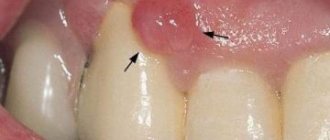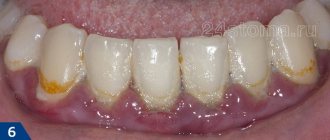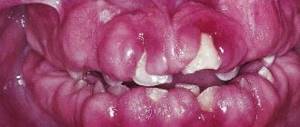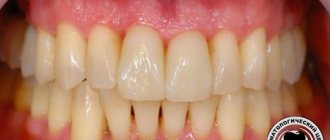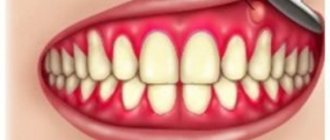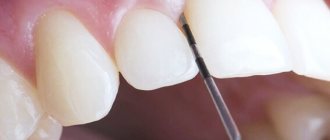Purulent gingivitis is a form of gum inflammation. The peculiarity of the disease is the formation of purulent discharge from the soft tissues of the gums and the formation of abscesses. The inflammatory process develops due to a bacterial infection and is accompanied by pain, swelling, redness of the gums, bad breath, and increased body temperature. To prevent the pathological process from affecting deeper tissues (periodontium), it is very important to start an effective course of treatment on time.
Causes
The main cause of gingivitis is believed to be microbial plaque. Microbial plaque appears when teeth are brushed incorrectly or irregularly. Microbial plaque also appears as a result of disruption of the natural cleaning of teeth. The cause of this disorder is the consumption of large amounts of carbohydrates (sweets), respectively, a decrease in the consumption of foods such as vegetables and fruits.
Reduced immunity plays an important role in the development of the disease. This leads to a weakened immune response and the development of a large number of microbes in the oral cavity.
Factors that increase the risk of developing gingivitis:
- Mouth breathing (not normal). Leads to the accumulation of various microorganisms in the oral cavity. With normal breathing (through the nose), microbes are neutralized in the nasal cavity;
- Changes in the quantity and quality of saliva secreted. As a rule, with this pathology, a reduced number of protective factors is found in saliva;
- Chemical injury to the gums - eating strong acids (acetic essence);
- Mechanical trauma to the gums (for example, due to careless brushing of teeth);
- Hormonal imbalances can lead to hypertrophic gingivitis;
- Physical trauma to the gums (usually due to eating foods that are too hot or too cold);
- Frequent hypothermia, sore throats. Lead to weakening of the body's defenses;
- Anomalies of dental development (deep bite, crowded teeth).
The inflammatory process in the gums develops as follows:
- Initial inflammation (acute gingivitis) occurs approximately 3-4 days after the formation of microbial plaque on the teeth. If a person has good immunity, the disease ends in a few days. When the immune system fails to cope, the disease becomes protracted.
- Secondary inflammation (chronic gingivitis) occurs 3-4 weeks after acute gingivitis. Chronic gingivitis occurs in phases: first there is an exacerbation, which is then replaced by a temporary remission (improvement of the condition). Then the phases are repeated.
Classification
External manifestations of gingivitis are manifested by its appearance. According to the form and differences in the clinical picture, the disease is divided into four groups:
| ulcerative-necrotic | characterized by a severe course, the standard manifestations of gum inflammation are accompanied by deterioration of the condition, hyperthermia, and ulcers form on the mucous membrane. |
| catarrhal | the simplest form and manifests itself in inflammation of the interdental papillae and marginal gums. At the same time, it becomes smoothed, relief is lost, bleeding occurs during probing and a large amount of both soft and mineralized plaque is determined. |
| atrophic | a pathological process opposite to the previous one is observed - a loss of soft tissue occurs, which leads to the formation of recessions. The disease is common among children. |
| hypertrophic | There is an overgrowth of soft tissues, due to which the crowns of the teeth are partially or completely hidden by the gum, which hurts and is very itchy, and also bleeds. |
Inflammation of the gums is not only an independent disease - some of its forms are concomitant and indicate the presence of disturbances in the functioning of the body.
Diagnostic methods
Typically, a dentist can diagnose gingivitis after a routine examination. But sometimes this is not enough to obtain a complete picture of the disease and exclude other dental diagnoses.
Methods for diagnosing gingivitis:
- Microbiological examination of saliva will help determine the number and composition of bacteria that caused inflammation.
- Dental X-ray - to determine the presence or absence of damage to the alveolar ligaments and exclude other diseases (periodontitis, periodontal disease).
- A general blood test will help determine the degree of inflammation and the general condition of the body.
- If there is severe tissue growth and major surgery is required, the doctor may recommend a capillary study.
Diagnosis and treatment of gingivitis is carried out by a dental therapist, but sometimes consultation with a periodontist and dental surgeon is required. If there are concomitant diseases (endocrine, hormonal, diseases of the gastrointestinal tract and ENT organs, immune disorders), it is advisable to consult with specialized specialists.
Symptoms of gingivitis, photos
There are general signs of developing gingivitis (see photo); of course, it is difficult to independently establish a diagnosis without special education and sufficient diagnostic experience. But every adult can determine that the inflammatory process is developing not in the tooth, but in the gum (the pathology can also manifest itself in children under three years of age).
The main symptoms of a developing inflammatory process will be:
- redness of the gums at the site of the outbreak of the disease, which indicates the beginning of the inflammatory process;
- swelling of the gums;
- bleeding;
- pain that intensifies as inflammation develops;
- the appearance of dental plaque, as a consequence of this process - an unpleasant odor from the oral cavity;
- an increase in the volume of periodontal papillae (this symptom can only be determined by a qualified specialist, as well as the formation of false pathological pockets);
- purple-blue tint.
It is important to remember that these are general symptoms that can appear all or in groups, depending on what type of gingivitis is present in the mouth and diagnosed by a specialist. In some people, symptoms may manifest themselves in completely different ways, which is why you should not even try to diagnose yourself and prescribe treatment.
Gingivitis - classification
Based on the form of the disease and the nature of its course, acute and chronic gingivitis is distinguished.
- The acute form begins with noticeable redness and bleeding of the gums. They swell and the interdental papillae enlarge.
- The chronic form is not so obvious, but the pathological process leads to the growth of gingival tissue and its “creeping” onto the tooth.
Depending on the type of inflammatory process, gingivitis occurs:
- Catarrhal
— exudative processes predominate, fluid is released from hyperemic gum tissue. There is a burning sensation in the oral cavity, there is heavy plaque on the teeth, and the papillae are swollen.
- Hypertrophic
— proliferative processes (tissue proliferation) predominate. In turn, hypertrophic gingivitis comes in two forms - edematous and fibrous. In the first form, the gums bleed and are painful, and in the second form, the gums are dense and no bleeding is observed.
- Ulcerative-necrotic
- the process goes deeper into the periodontal tissue, causing, in addition to pain and bleeding, ulceration of the gums. The general condition suffers, the lymph nodes enlarge. If left untreated, this type of gingivitis can develop into Vincent gingivitis, which affects the entire mouth.
Dentists also distinguish mixed varieties of the disease.
Diagnostics
Gingivitis must be distinguished from periodontitis and periodontal disease. The main feature that distinguishes gingivitis from other periodontal diseases is that the inflammatory process affects only the gum tissue, the remaining structures (periodontal ligaments that hold the tooth in the jaw and bone tissue) remain unchanged. Normally, the depth of the dentogingival junction is 1-1.5 mm; with the destruction of the dentogingival junction, periodontal pockets (4 mm or more in depth) are observed, which are a sign of periodontitis.
With gingivitis, there are no periodontal pockets, but there are false periodontal pockets that form with the hypertrophic form of gingivitis, and in general with any swelling of the gums. Along with this symptom, gingivitis is not characterized by periodontal pockets, exposure of the necks of the teeth, or their mobility - these signs indicate damage to the bone apparatus. For differential diagnosis, radiography is used - changes in the height of the interalveolar septa are not typical for gingivitis.
Among the advanced technologies, genetic testing can be noted, which can show all the risks by performing a test for genetic polymorphism in individuals predisposed to increased production of interleukin-1 (IL-1), which is a mediator of inflammation.
Treatment of gingivitis
For gum inflammation that has developed due to poor hygiene, general treatment is not required. In any case, it will not be superfluous to have a properly balanced diet and take vitamins. If the inflammatory process in the gums causes a change in a person’s well-being - headache, weakness, nausea, increased body temperature, abnormal stool and enlarged lymph nodes - local treatment must be combined with general treatment.
Often prescribed (if necessary) are Metronidazole (0.25–3 r./day), Lincomycin (0.25–2 r./day), Biseptol (2 tablets 2 r./day), Diflucan (1 r./day ), Bifiform (2 capsules 1 r./day) for a course of treatment and other medications. Often, gingivitis can occur against the background of diseases such as stomatitis, tonsillitis, tonsillitis, so the choice of medications for its treatment is best left to a specialist.
Treatment of chronic gingivitis:
- Professional hygiene: removal of hard and soft plaque;
- Training in oral hygiene and selection of individual teeth cleaning products, control of acquired skills in the future;
- General strengthening therapy: vitamins, drugs that improve blood circulation;
- Treatment of diseased teeth;
- Local therapy: use of antiseptic, anti-inflammatory ointments, gels, rinses;
- If necessary, correcting the bite or inserting missing teeth.
Treatment of acute gingivitis differs in that antimicrobial and anti-inflammatory therapy comes first. After the swelling subsides and the gums stop hurting, they begin to fight catarrhal gingivitis in the same way as described above.
Hypertrophic gingivitis: symptoms, treatment methods
It is characterized by fibrous growth or an increase in the volume of the gums due to swelling. Occurs due to disturbances in the endocrine system, hormonal imbalances and malocclusion.
Treatment will depend on the form of the disease:
- the edematous form involves the use of sclerotherapy, that is, when a special solution consisting of glucose, calcium chloride and magnesium sulfate is injected into the gingival papillae. The procedure is carried out with anesthesia; at least 3 injections are required into each papilla with a break of 2 days.
- in the fibrotic form, deposits are removed and factors traumatic to the gums are eliminated, then anti-inflammatory therapy is prescribed, including applying bandages with heparin ointment and other medications.
Treatment of hypertrophic gingivitis
In this case, the treatment plan corresponds to the treatment plan for catarrhal gingivitis, but after the stage of sanitation of pathological teeth, surgical removal of excessive gum growth occurs.
Moreover, before the operation, fibrous hypertrophic gingivitis is treated as chronic catarrhal, edematous – as acute catarrhal. In the presence of leukemia, only symptomatic treatment is performed; gum overgrowth is not removed.
Treatment of ulcerative gingivitis
The treatment regimen is as follows:
- Treatment of ulcers: first, anesthesia is performed, then with the help of enzymes and instruments, the gums are cleared of ulcers;
- Fighting dental plaque. This stage includes mandatory antiseptic treatment of the entire oral cavity and superficial anesthesia using a gel;
- Taking antibiotics (metronidazole orally);
- Local antibacterial therapy with metronidazole;
- After healing begins, local wound-healing preparations are used (oil solutions of vitamins A, E, sea buckthorn);
- Anti-inflammatory therapy;
- Antiallergic drugs;
- After recovery – treatment of diseased teeth;
- General restorative therapy: vitamins, possible prescription of immunomodulators.
In case of ulcerative gingivitis, they are required to issue a certificate of incapacity for work (sick leave) for several days.
Therapy in pregnant women
Problems traditionally arise with the treatment of pregnant women, since most medications are not recommended in this situation. Therefore, treatment for gingivitis must first and foremost be safe.
Treatment regimen for gingivitis in pregnant women:
- They start by removing tartar using ultrasound; this is absolutely safe for the baby, although some are mistaken, considering ultrasonic waves harmful.
- Herbal preparations for treating the oral cavity. For both treatment and prevention, rinsing the mouth with a decoction of oak bark is recommended. The drug Maraslavin has proven itself to be the most effective. This is a collection of five herbal ingredients that have anti-inflammatory, antiseptic effects, reduce swelling and bleeding of the gums. The solution is diluted with water one to one, and the mouth is rinsed 3 times a day.
- Chlorhexidine and Furacilin mouth rinses are safe.
- In case of severe bleeding gums, you can use: hydrogen peroxide or applications of Heparin ointment and Aspirin.
- Physiotherapy in the gum area is also safe for the expectant mother and baby.
- It is important to maintain good oral hygiene. From the very beginning of pregnancy, it is good to use antibacterial toothpastes, which work better against plaque. And if this paste also contains herbal anti-inflammatory ingredients, then this is an ideal option.
Such pastes are available in the Lakalut, Parodontol, President and many other brands. To rinse the mouth after eating, it is recommended to use plant-based balms-rinses.
Treatment methods
Local treatment is usually sufficient to treat uncomplicated gingivitis; in severe cases, antibiotics and surgery may be necessary. Additionally, the doctor may recommend a diet to reduce the burden on inflamed gums and also support the immune system.
Cleaning teeth from stone and plaque, treating caries lesions are the first stages of therapy. Their goal is to eliminate the root cause, the source of infection. If the plaque is not removed, the treatment will be ineffective, and after a while the disease will recur.
Next, the doctor prescribes antimicrobial and restorative treatment. Depending on the stage of the disease, they may take 10-20 days.
The goal of local treatment is to quickly relieve symptoms, relieve pain and remove inflammation. For this purpose, rinsing solutions, herbal decoctions, ointments and gels are used.
It is important not to eat or drink for at least an hour after rinsing. It is also forbidden to swallow rinses - if they enter the stomach, they can cause inflammation of the mucous membrane and even severe poisoning.
Alcohol-based solutions should be used with caution: they can burn or dry out the mucous membrane, which will lead to even greater inflammation.
Ointments and gels are rubbed into the gums and left for a while. They provide a lasting disinfectant and anti-inflammatory effect and stimulate healing processes.
The effect of treatment is enhanced if you use anti-inflammatory toothpastes. But bleaching agents with abrasives should be avoided: they can damage already inflamed gums.
Prevention
To avoid disease, it is important, first of all, to adhere to hygiene rules: brush your teeth twice a day to remove bacterial plaque, choose the right toothbrush, rinse your mouth after eating, and visit the dentist’s office for preventive purposes. You also need:
- Eat right - include more vitamin-rich foods, fiber in your diet, limit sweets and fast carbohydrates;
- Treat infectious and inflammatory diseases of the oral cavity and caries in a timely manner;
- Periodically perform professional teeth cleaning and tartar removal;
- Strengthen immunity.
At the first signs of the development of an inflammatory process, you should consult a doctor to prevent inflammation from spreading deep into the gum tissue and developing complications.
Toothpastes
No matter how painful and unpleasant it may be, a sick person needs to brush their teeth twice a day. It is forbidden to spare or injure, so a toothbrush should be of medium hardness. Toothpaste should be chosen with an anti-inflammatory and healing effect; it should contain sage, chamomile, calendula, and yarrow. They reduce swelling and bleeding, strengthen the gums.
Whitening toothpastes are not used for gingivitis because they contain abrasives that can cause injury when brushing and should be put aside until the gums are healthy again.
Nutrition rules
The diet of a person suffering from gingivitis should include as many fresh fruits and vegetables as possible.
- Apples and pears contain pectin and microelements that accelerate the regeneration process.
- A large amount of vitamin C, which helps strengthen blood vessels and reduce bleeding, is found in citrus fruits.
- Vegetables are rich in fiber and antioxidants. By including cabbage, carrots and zucchini in the menu, you can speed up metabolic processes in the body and reduce the time of gum regeneration (healing).
- Berries (blackberries, currants, raspberries) enrich the body with vitamins and minerals, increasing its overall immunity.
You should not eat food containing fast carbohydrates (flour products, potatoes, sweets) in large quantities, as they contribute to the formation of soft plaque.
Folk remedies
To speed up treatment, you can use various rinses and baths from a decoction of medicinal herbs. Recipes for making infusion:
- Celandine and oak bark have astringent properties. They relieve swelling and bleeding from gum inflammation. Crushed oak bark and dried celandine herb are used. To prepare the infusion, they are mixed: two tablespoons of each are poured with two glasses of boiling water. After the infusion has cooled at room temperature, you should rinse your mouth four times a day while the symptoms persist.
- Pour 200 ml of boiling water over a tablespoon of sage and leave for 20 minutes. Wait for the broth to cool and rinse your mouth after each meal. You can also prepare an infusion of chamomile. It has bactericidal properties and accelerates the gum healing process.
If you use traditional medicine, then discuss your actions with a periodontist. Advice from unenlightened people should be ignored.
Catarrhal gingivitis: symptoms and treatment
The main reason for its development lies in poor hygiene. Plaque accumulates on the surface of the teeth, including on their necks, which gradually hardens, turning into stone.
In addition to neglect of hygiene, catarrhal gingivitis can be caused by a lack of vitamin C in the body, hormonal imbalances and blood diseases. This form of the disease is the most common, occurring very often in women carrying a child.
The disease can be distinguished by the following symptoms:
- swelling of the gum edge, its redness or cyanosis;
- bleeding and pain during cleaning;
- plaque visible to the naked eye.
Catarrhal gingivitis can be:
- acute - this condition is characterized by the rapid development of symptoms;
- chronic, when the symptoms are mild, exacerbating only during periods of weakened immunity (for example, during a cold).
Catarrhal gingivitis: treatment in adults
Since the cause of gingivitis is plaque, the first step is to eliminate it. You can get rid of it by using a regular brush, but if the plaque has managed to mineralize and turn into stone, then you will have to spend time visiting the dentist.
Plaque mineralizes within less than 16 hours from the moment it forms: this is how tartar appears.
So, the main stages of treatment:
- Removing plaque and tartar. Ultrasonic cleaning has proven itself to be the best, after which it is imperative to undergo the procedure of polishing the teeth and treating the gums with gel. Typically, the total session duration is one hour. As practice shows, even after completing this stage of the treatment process, the patient feels much better.
- Anti-inflammatory therapy. Since catarrhal gingivitis affects only the surface of the gums, treatment can be carried out at home. It takes 10 days, then you will need to visit the doctor again for a follow-up examination. In most cases, anti-inflammatory gels are prescribed, which should be applied to the gums, rinses with Chlorhexidine, and a special toothpaste.
Description of anti-inflammatory therapy
For gingivitis treatment to be effective, it is recommended to treat the gums twice a day. Of the wide variety of gels, it is worth using “Cholisal Gel”, and using Chlorhexidine 0.05% as a rinse solution. The widely advertised Metrogyl Denta gel is slightly less effective.
The procedure is as follows: after waking up, routinely brushing your teeth (it is better to buy a Soft brush during treatment) and breakfast, you should thoroughly rinse your mouth with Chlorhexidine, then dry the surface of the gums with gauze and rub it with your finger. The gel should be applied both from the outside of the teeth and from the tongue. After treating your gums with gel, you should not drink or eat for at least half an hour. Some components of the product can cause salivation: saliva can be swallowed without fear, since it does not contain anything harmful to health.
It is necessary to clearly understand that curing gingivitis and then returning to your previous lifestyle means dooming yourself to the recurrence of symptoms in the near future. To prevent this from happening, prevention is important, which consists of properly brushing your teeth after every meal. Minimizing the risk of relapse is also influenced by the absence of caries, so carious cavities must be healed.
Prevention
Prevention is quite simple and everyone, if desired, can protect themselves from inflammatory gum diseases. You just need to follow a few simple rules:
- using electric toothbrushes;
- maintaining oral hygiene (toothpastes, gels, rinses);
- to give up smoking;
- dental gels with metronidazole, for example Metrogyl Denta;
- ambazon, 2,4-dichlorobenzyl alcohol, amylmetacresol in the form of lozenges;
- use of toothpastes with triclosan;
- use of calcium supplements;
- rinsing the mouth with solutions containing chlorhexidine, hydrogen peroxide, ethanol, thymol, cineol, methyl salicylate, menthol, methylparaben, benzalkonium chloride, fluorides and xylitol. Recent scientific research has also shown the beneficial effects of mouthwashes containing essential oils.
The above preventive measures are also used for treatment. The use of dental floss is not advisable.
What happens if gingivitis is not treated?
Many forms of gingivitis do not seem dangerous at first glance, especially when the acute stage passes. A person gets used to mild pain and bleeding, so he does not go to the doctor. However, if gingivitis is not treated in time, it can lead to the following unpleasant consequences:
- Periodontitis is an inflammatory disease of the gums, in which teeth become loose and fall out, causing severe pain and bad breath.
- Frequent caries and throat diseases.
- The gums have receded to such an extent that the exposed roots of the teeth begin to cause severe discomfort.
- The spread of inflammation to the jaw bones and the body as a whole, a serious deterioration in overall health, in the worst case, even blood poisoning.
In addition, gingivitis is usually a sign of other unpleasant diseases or conditions, such as poor oral hygiene, which can cause serious dental problems.
All this means that at the first signs of gingivitis, you need to contact your dentist for treatment.





